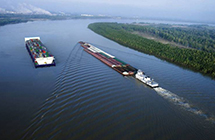 |
 |
|
| eNews • April 2017 | ||
| Promoting a Cost-Effective, Reliable and Competitive Transportation System |
||
 Mississippi River container terminal faces steep climb
Mississippi River container terminal faces steep climb
Backers of a proposed Mississippi River container terminal between New Orleans and the Gulf of Mexico say they expect large, self-propelled inland vessels will help them succeed in what some view as a long-shot effort to lure cargo from other US coasts.
The Plaquemines Port, Harbor and Terminal District and American Patriot Holdings (APH) unveiled parallel plans for a deepwater container terminal, and a fleet of shallow-draft vessels that would feed containers between the port and Memphis and St. Louis.
ââ¬Å"Our goal is to take cargo away from other gateways like LA-Long Beach and New York,ââ¬Â said Joseph Gehegan, an APH executive and former CEO of U.S. Shipping Corp. APH and port officials say efficient water transport will provide ââ¬Å"substantialââ¬Â savings to and from the US Midwest.
It wonââ¬â¢t be simple or easy. The service would face stiff competition from existing services using the West and East coasts, and from Canadian National Railway, which is working to expand its intermodal service from Mobile, Alabama, and New Orleans.
ââ¬Å"Theyââ¬â¢ll be competing against a very well-entrenched system that will be faster, and the railroads theyââ¬â¢ll be competing against will fight them tooth and nail,ââ¬Â said Asaf Ashar, a port consultant and research professor emeritus at the National Ports & Waterways Institute.
Ashar questioned the size of the potential market for the planned service, which would use inland vessels with capacities of 1,826 to 2,960 twenty-foot-equivalent units (TEUs). He noted that for Asian cargo, West Coast ports have big advantages in ocean transit time and sailing frequency.
APH and port officials say their point-to-point transit times would be comparable and that costs would be lower. ââ¬Å"[Beneficial cargo owners (BCOs)] would prefer a slightly longer transit time if they can reduce their overall delivered costs,ââ¬Â said Sandy Sanders, the Plaquemines portââ¬â¢s executive director.
The Plaquemines project is still in a preliminary stage. APH and the port district said theyââ¬â¢ve finished a ââ¬Å"pre-feasibility reportââ¬Â that theyââ¬â¢ll pitch to potential investors, terminal operators, BCOs, and container lines.
The port and APH have signed an ââ¬Å"exclusivity agreementââ¬Â to jointly develop a system that would combine APHââ¬â¢s inland vessels with deepwater and inland container terminals that a private terminal operator would run.
Port consultant John Vickerman has been involved in the terminalââ¬â¢s design, which would be developed in stages and eventually feature 15 container gantry cranes and annual capacity of 2.1 million TEUs. The first phase would have two berths and cost an estimated $373 million, Sanders said.
The riverââ¬â¢s minimum channel depth on its lower reaches is 45 feet, and the Army Corps of Engineers has proposed to deepen it to 50 feet by dredging shallow spots.
The proposed terminal would be on the riverââ¬â¢s west bank, near where a large ââ¬Å"Millennium Portââ¬Â was proposed about 15 years ago when the Port of New Orleans was trying to decide where to expand its container facilities.
New Orleans ultimately opted to concentrate its container activities at its Napoleon Ave. terminal, which last year handled 369,914 TEUs of full containers, excluding empty boxes, according to PIERS, a sister division of JOC.com within IHS Markit.
APH officials say theyââ¬â¢re not targeting cargo that New Orleans currently handles. Instead, they plan to solicit cargo moving to or from points farther upriver.
The inland part of APHââ¬â¢s planned service would use container vessels with patented features including an ââ¬Å"exoskeletonââ¬Â hull structure that maximizes payload and a bow design that allows 13-knot speed with minimal wakes.
The vessels would be fueled by liquefied natural gas and would have Z-drive propulsion that eliminates the need for docking tugs. They would draw a maximum of nine feet of fresh water, and would have overall lengths ranging from 592 to 952 feet.
APH plans to seek bids to build four of the vessels and run them on round-trip voyages of seven days to Memphis and 11 days to St. Louis. They said the plan is to have regular gantry cranes that will provide quick turnaround at the inland ports.
Since the 1970s, there have been several efforts to use the river system for container movement. About 15 years ago, SeaPoint proposed a transfer station near the mouth of the river for moving containers between ships and barges.
Last year, Seacor launched a container-on-barge service that repositions empty containers from Memphis to Baton Rouge for loading with synthetic resins that are barged downriver to New Orleans for export. The service uses hopper barges that hitch a ride on multibarge tows that are headed downriver anyway.
Several attempts to establish two-way container services on the river have fizzled since the late 1970s. Sal Litrico, APHââ¬â¢s chief executive, said the earlier services were irregular and low-volume, but that APHââ¬â¢s will succeed by providing ââ¬Å"a fast predictable, dedicated liner service.ââ¬Â
Ashar is skeptical. He noted that a key reason for the failure of several of the earlier container-on-barge ventures was competition from north-south rail services that can easily adjust rates or add capacity. ââ¬Å"The big question is still the parallel rail system,ââ¬Â he said. ââ¬Å"I think theyââ¬â¢re facing big obstacles.ââ¬Â
Source: Journal of Commerce
Soy Transportation Coalition |
|
